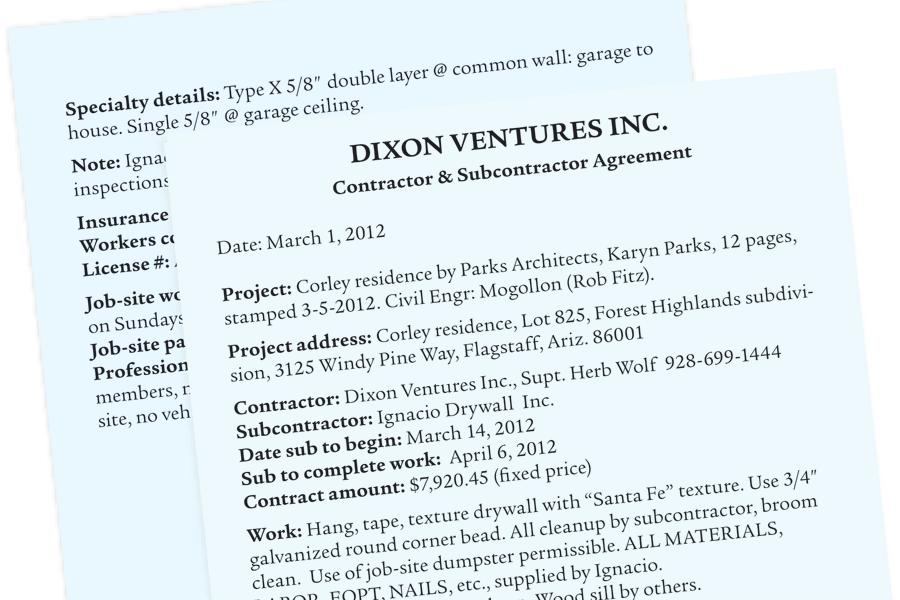Work Processes
After project location and scope, the next-most important sections relate to payment schedules and the paperwork I need before writing a check.
Payment schedule. I keep this to-the-point and specific to every trade. For example, for drywall I might say: “All hung and passed nailing inspection, 35 percent of the draw; taped, 25 percent; balance when sanded, textured, and cleaned, and scrap removed.” Or for hvac: “75 percent of payment can be made after the furnaces and ductwork are set and system is operable for construction basis; balance on system trim, test, balance, completion.”
Invoicing, lien waivers, and other paperwork. These requirements are the same for everyone. Up-to-date liability insurance and workers’ comp certificates, license, and bond details must be on file at my office before the first draw is paid. I’m not going to hound anyone for this stuff. No paperwork means no pay.
When I send the check for the first draw, I include with it a lien waiver form and a prestamped, preaddressed envelope. The next draw won’t be paid until I get the signed form back. (In Arizona, where I live, you can’t lien a property unless you have a contract with the property owner, but I insist on the waiver anyway.)
Items needed before final payment. Items like keys, alarm codes, garage-door openers, and product documentation are easy to forget. That’s why I need them in hand before writing the final check.
Work hours. These are usually 7 a.m. to 6 p.m., Monday to Friday.
Change-order procedures. All changes must be authorized by my project manager or me.
Materials storage. Subs have to keep their stuff out of other people’s way. If the roof trusses are delivered three weeks early, it’s up to the framing sub to get them out of the driveway.
Warranty. The contract notes any nonstandard warranty issues and requires the sub to tell me about conditions that will void a warranty — such as when the owners want to put a moving van on the driveway 10 days after the concrete has been placed, even though the warranty requires a 30-day wait.
Contractor responsibility. The contract also includes a section that puts responsibilities on my company. We agree to reconfirm scheduled work with all subs at least three days in advance and to notify them of any changes, delays, or problems. This reminds subs that we’re on the same team and that I’ll watch out for their interests.
Setting Expectations
The people-related sections define how we expect everyone to behave. They’re not as critical as scopes and payments, but they set standards for professionalism and make it clear to subs that I expect them to live up to those standards.
Self-supervision. All subs have to manage their own work. If a plumber shows up and asks my project manager or me what to do, we tell him to call his office.
Visitors. No pets, family members, or visitors are allowed on site without our permission. Common sense is in order here: If the painter’s wife comes by to tell him something, that’s fine; if he’s working with his kids sitting in the car, that’s not.
Self-administration. Subs are responsible for scheduling their own inspections and deliveries and protecting their own materials from the elements.
Personnel. We make it clear that subs have to provide qualified people. We’re not babysitters.
Professionalism. The contract requires professional and courteous behavior, common sense, and consideration of project neighbors. If someone doesn’t understand what those terms mean, he’s probably not a good fit for us.
Feedback. This part of the contract welcomes suggestions from subs. It reminds them that we’re reasonable, that we will listen to their ideas, and that we understand that the contract is as much in their interest as ours.
Dennis Dixon is a licensed general contractor in Flagstaff, Ariz., and a regular speaker at JLC Live.
